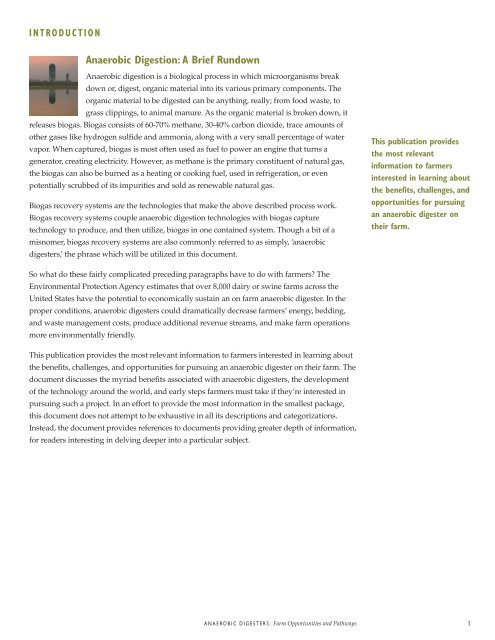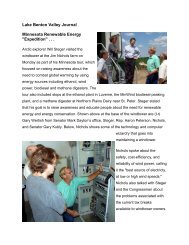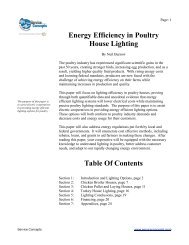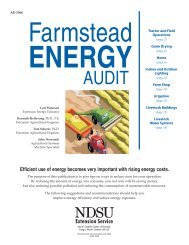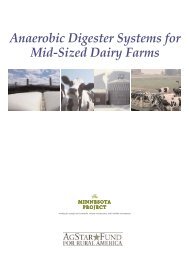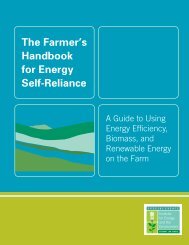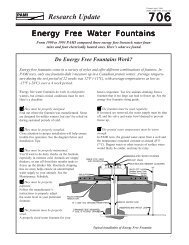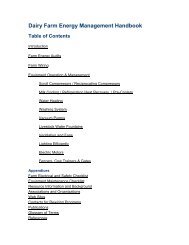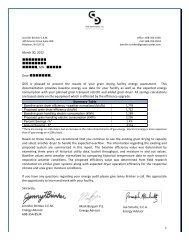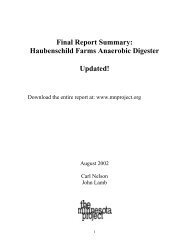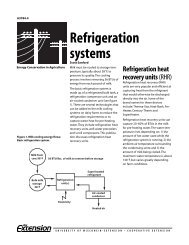Anaerobic Digesters - The Minnesota Project
Anaerobic Digesters - The Minnesota Project
Anaerobic Digesters - The Minnesota Project
You also want an ePaper? Increase the reach of your titles
YUMPU automatically turns print PDFs into web optimized ePapers that Google loves.
INTRODUCTION<br />
<strong>Anaerobic</strong> Digestion: A Brief Rundown<br />
<strong>Anaerobic</strong> digestion is a biological process in which microorganisms break<br />
down or, digest, organic material into its various primary components. <strong>The</strong><br />
organic material to be digested can be anything, really; from food waste, to<br />
grass clippings, to animal manure. As the organic material is broken down, it<br />
releases biogas. Biogas consists of 60-70% methane, 30-40% carbon dioxide, trace amounts of<br />
other gases like hydrogen sulfide and ammonia, along with a very small percentage of water<br />
vapor. When captured, biogas is most often used as fuel to power an engine that turns a<br />
generator, creating electricity. However, as methane is the primary constituent of natural gas,<br />
the biogas can also be burned as a heating or cooking fuel, used in refrigeration, or even<br />
potentially scrubbed of its impurities and sold as renewable natural gas.<br />
Biogas recovery systems are the technologies that make the above described process work.<br />
Biogas recovery systems couple anaerobic digestion technologies with biogas capture<br />
technology to produce, and then utilize, biogas in one contained system. Though a bit of a<br />
misnomer, biogas recovery systems are also commonly referred to as simply, ‘anaerobic<br />
digesters,’ the phrase which will be utilized in this document.<br />
So what do these fairly complicated preceding paragraphs have to do with farmers? <strong>The</strong><br />
Environmental Protection Agency estimates that over 8,000 dairy or swine farms across the<br />
United States have the potential to economically sustain an on farm anaerobic digester. In the<br />
proper conditions, anaerobic digesters could dramatically decrease farmers’ energy, bedding,<br />
and waste management costs, produce additional revenue streams, and make farm operations<br />
more environmentally friendly.<br />
This publication provides the most relevant information to farmers interested in learning about<br />
the benefits, challenges, and opportunities for pursuing an anaerobic digester on their farm. <strong>The</strong><br />
document discusses the myriad benefits associated with anaerobic digesters, the development<br />
of the technology around the world, and early steps farmers must take if they’re interested in<br />
pursuing such a project. In an effort to provide the most information in the smallest package,<br />
this document does not attempt to be exhaustive in all its descriptions and categorizations.<br />
Instead, the document provides references to documents providing greater depth of information,<br />
for readers interesting in delving deeper into a particular subject.<br />
This publication provides<br />
the most relevant<br />
information to farmers<br />
interested in learning about<br />
the benefits, challenges, and<br />
opportunities for pursuing<br />
an anaerobic digester on<br />
their farm.<br />
ANAEROBIC DIGESTERS: Farm Opportunities and Pathways 1


